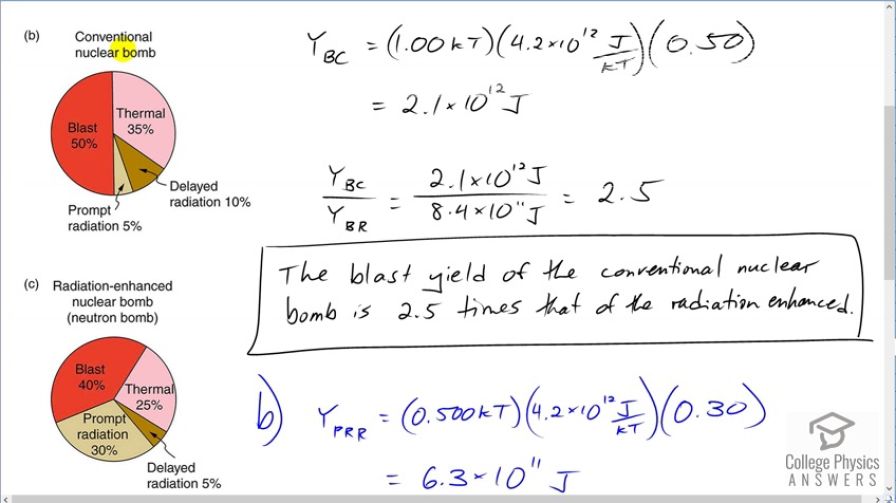Question
A radiation-enhanced nuclear weapon (or neutron bomb) can have a smaller total yield and still produce more prompt radiation than a conventional nuclear bomb. This allows the use of neutron bombs to kill nearby advancing enemy forces with radiation without blowing up your own forces with the blast. For a 0.500-kT radiation-enhanced weapon and a 1.00-kT conventional nuclear bomb: (a) Compare the blast yields. (b) Compare the prompt radiation yields.
Final Answer
- The blast yield of the conventional nuclear bomb is 2.5 times that of the radiation enhanced bomb.
- The prompt radiation yield of the radiation enhanced nuclear weapon is 3.0 times that of the conventional nuclear weapon.
Solution video
OpenStax College Physics for AP® Courses, Chapter 32, Problem 55 (Problems & Exercises)

vote with a rating of
votes with an average rating of
.
Calculator Screenshots
Video Transcript
This is College Physics Answers with Shaun Dychko. We are going to compare the blast yield and the prompt radiation yield between a conventional nuclear bomb and a radiation enhanced nuclear bomb. So radiation enhanced means that the reaction is tuned such that the amount of radiation as a percentage of the total yield is much greater and the blast yield is reduced. And the strategic purpose of this is to create less physical destruction but at the same time increase this immediate radiation and the idea is to use this in a scenario where there are enemy troops advancing and the troops will get destroyed by this radiation and your friendly troops that are not too far away won't get damaged by the blast from this bomb because the blast is smaller. OK And the idea is that the radiation will only the troops that are close to the bomb, the enemy troops in other words will get exposed to this radiation because the friendly troops are far enough away that they don't get exposed to that. Okay so here we go; we have the total yield of our radiation enhanced bomb is 0.500 a kiloton and the total yield of our conventional nuclear bomb is 1 kiloton and let's compare the blast yields. So the blast yield of the radiation enhanced bomb will be half a kiloton we are told is the total yield convert that into joules by multiplying by 4.2 times 10 to the 12 joules per kiloton then times by 40 percent because that's what we see in this pie chart— blast yield is 40 percent of the total— and so we get 8.4 times 10 to the 11 joules of energy released in the form of blast energy. For the conventional nuclear bomb, it's a 1 kiloton bomb converted into joules times 0.50 since half of the total yield of conventional bomb is blast yield and that gives 2.1 times 10 to the 12 joules and take the ratio of those two and we see that the blast yield of the conventional nuclear bomb is 2.5 times that of the radiation enhanced bomb and we expected that; we expected the blast yield to be greater for the conventional than for the radiation for two reasons; one is as a percentage of the total, the conventional nuclear bomb gives greater of its yield to the blast form and then furthermore the total yield of the conventional bomb in this case is twice that of the radiation enhanced one. Then we compare the prompt radiation outputs of both these. So for the radiation enhanced bomb we have half a kiloton converted into joules times 30 percent and that gives 6.3 times 10 to the 11 joules and for the conventional bomb, it has 1 kiloton converted into joules times only 5 percent of its yield is in the form of prompt radiation and that is 2.1 times 10 to the 11 joules and so taking a ratio of these two, we see that the prompt radiation yield of the radiation enhanced nuclear weapon is 3 times that of the conventional nuclear weapon despite the fact that the total yield of the radiation enhanced bomb is only half of the total yield of the conventional.

